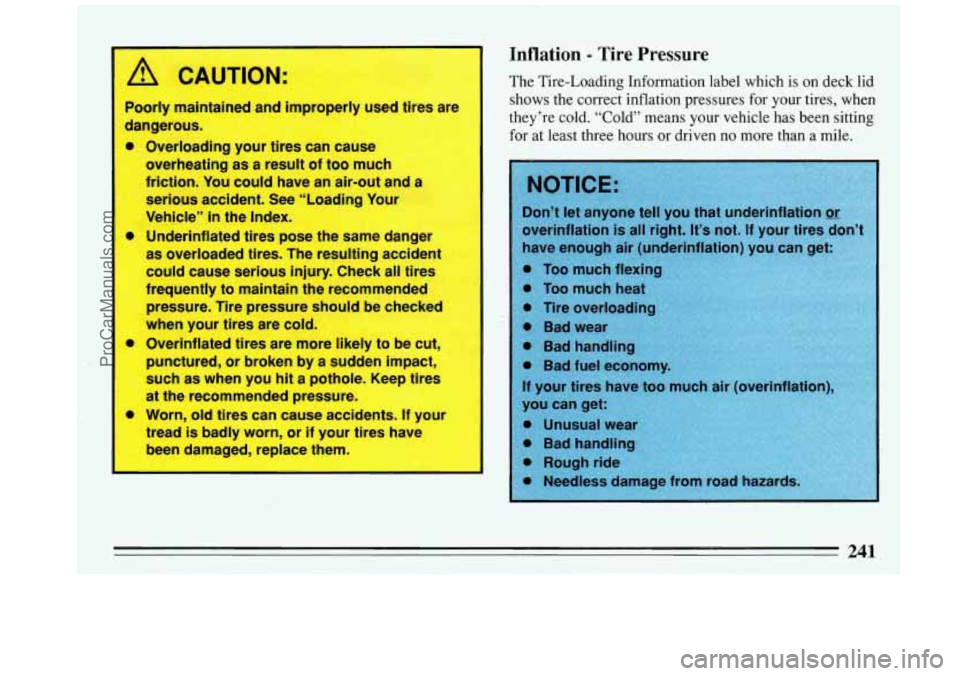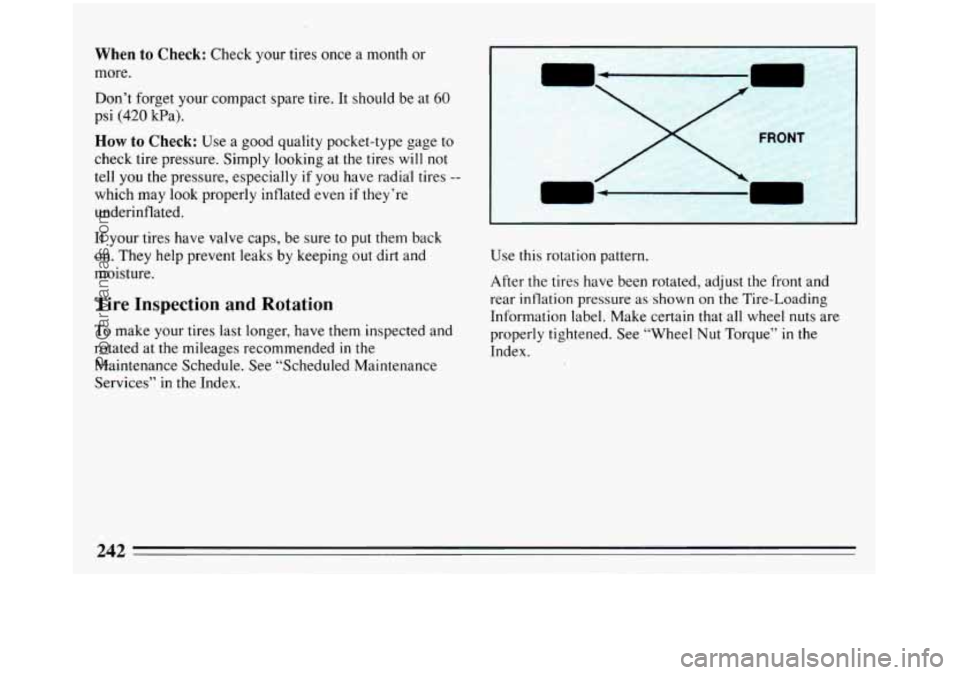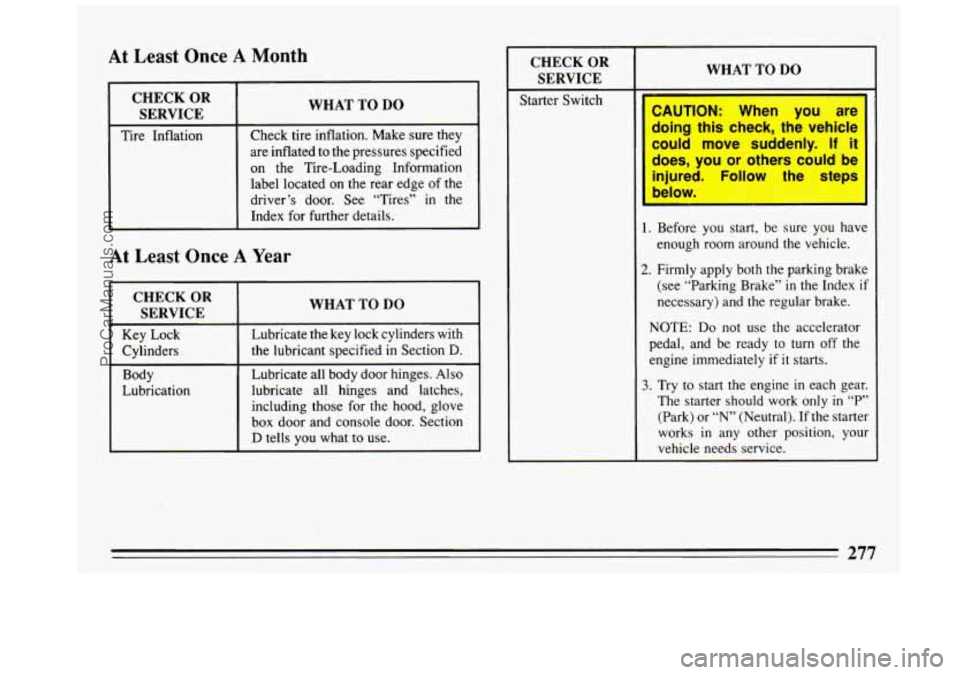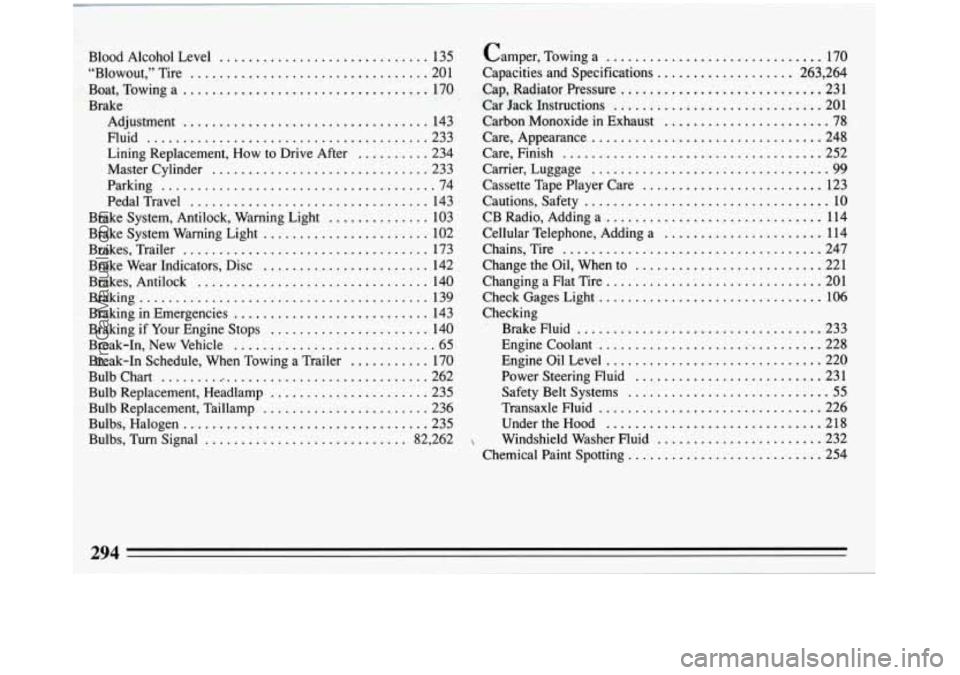1993 BUICK REGAL Tire pressure
[x] Cancel search: Tire pressurePage 243 of 308

A CAUTION:
Poorly maintained and improperly used tires are
dangerous.
0
Overloading your tires can cause
overheating as a result
of too much
friction. You could have an air-out and a
serious accident. See “Loading Your
Vehicle”
in the Index.
Underinflated tires pose the same danger
as overloaded tires. The resulting accident
could cause serious injury. Check all tires
frequently to maintain the recommended
pressure. Tire pressure should be checked
when your tires are cold.
Overinflated tires are more likely to be cut,
punctured, or broken by
a sudden impact,
such as when you
hit a pothole. Keep tires
at the recommended pressure.
Worn, old tires can cause accidents.
If your
tread
is badly worn, or if your tires have
been damaged, replace them.
Inflation - Tire Pressure
The Tire-Loading Information label which is on deck lid
shows the correct inflation pressures for your tires, when
they’re cold. “Cold” means your vehicle has been sitting
for at least three hours or driven
no more than a mile.
241
ProCarManuals.com
Page 244 of 308

When to Check: Check your tires once a month or
more.
Don’t forget your compact spare tire. It should be at
60
psi (420 kPa).
How to Check: Use a good quality pocket-type gage to
check tire pressure. Simply looking at the tires will not
tell
you the pressure, especially if you have radial tires --
which may look properly inflated even if they’re
underinflated.
If your tires have valve caps, be sure to put them back
on.
They help prevent leaks by keeping out dirt and
moisture.
Tire Inspection and Rotation
To make your tires last longer, have them inspected and
rotated at the mileages recommended
in the
Maintenance Schedule. See “Scheduled Maintenance
Services”
in the Index.
I
I‘
Use this rotation pattern.
After the tires have been rotated, adjust the front and
rear inflation pressure
as shown on the Tire-Loading
Information label. Make certain that all wheel nuts are
properly tightened. See “Wheel Nut Torque”
in the
Index.
242
ProCarManuals.com
Page 251 of 308

0 Use solvent-type cleaners In a well-ventilated area
only. If you use them, don’t saturate the stained area.
If a ring forms after spot cleaning, clean the entire
area immediately or it will set.
Using Foam-Type Cleaner on Fabric
0
0
0
0
0
0
0
0
0
0
Vacuum and brush the area to remove any loose dirt.
Always clean a
whole trim panel or section. Mask
surrounding trim along stitch or welt lines.
Mix Multi-Purpose Powdered Cleaner following the
directions
on the container label.
Use suds only and apply with a clean sponge.
Don’t saturate the material.
Don’t rub
it roughly.
As soon
as you’ve cleaned the section, use a sponge
to remove
the suds.
Rinse the section with a clean, wet sponge.
Wipe off what’s left with a slightly damp paper towel
or cloth.
Then dry it immediately with an air hose, a hair
dryer
or a heat lamp.
I NOTICE:
I
Be careful with a hair dryer or heat lamp. You
could scorch the fabric.
I
Wipe with a clean cloth.
Using Solvent-Type Cleaner on
Fabric
First, see if you have to use solvent-type cleaner at all.
Some spots and stains will clean off better with just
water and mild soap.
If you need to use it, then:
0 Gently scrape excess soil from the trim material with
a clean, dull knife or scraper. Use very little cleaner,
light pressure and clean cloths (preferably
cheesecloth). Cleaning should start at the outside
of
the stain, “feathering” toward the center. Keep
changing
to a clean section of the cloth.
the area with an air hose, hair dryer, or heat lamp to
help prevent a cleaning ring. (See the previous
NOTICE.)
0 When you clean a stain from fabric, immediately dry
249
ProCarManuals.com
Page 279 of 308

At Least Once A Month
CHECK OR
SERVICE
Tire Inflation
WHAT TO DO
Check tire inflation. Make sure they
are inflated
to the pressures specified
on the Tire-Loading Information
label located on the rear edge of
the
driver’s door. See “Tires” in the
Index for further details.
c!%&lkY 1 --“-+
Starter Switch
At Least Once A Year
I CHECKOR
SERVICE
I WHAT TO DO
Key Lock
the lubricant specified in Section
D. Cylinders Lubricate the
key lock cylinders with
Body
Lubrication Lubricate all
body door hinges.
Also
lubricate all hinges and latches,
including those for the hood, glove
box door and console door. Section
D tells you what to use.
1. Before you start, be sure you have
enough room around the vehicle.
2. Firmly apply both the parking brake
(see “Parking Brake”
in the Index if
necessary) and the regular brake.
NOTE:
Do not use the accelerator
pedal, and
be ready to turn off the
engine immediately if
it starts.
3. Try to start the engine in each gear.
The starter should work only in “P”
(Park) or
“N” (Neutral). If the starter
works
in any other position, your
vehicle needs service.
277
ProCarManuals.com
Page 296 of 308

......................
?.'rrrrir.rr.*..s ..r.. *rrrlr)ry)r* 14p A ..
..... * ......... L . li e 0 $ 1 .... . i., . 5 ; ....... ?. . * .
Camper. Towing a .............................. 170
Capacities and Specifications ................... 263. 264
Car Jack Instructions ............................. 201
Carbon Monoxide in Exhaust ....................... 78
Care. Appearance ................................ 248
Care. Finish .................................... 252
Carrier. Luggage ................................. 99
Cassette Tape Player Care ......................... 123
Cautions. Safety .................................. 10
Cellular Telephone. Adding a ...................... 114
Chains. Tire .................................... 247
Changing a Flat Tire ............................... 201
Checking Cap. Radiator Pressure
............................ 231
CB Radio. Adding a .............................. 114
Change the Oil. When to .......................... 221
Check Gages Light ............................... 106
Brake Fluid .................................. 233
Engine Coolant ............................... 228
Engine Oil Level .............................. 220
Power Steering Fluid .......................... 231
Safety Belt Systems ............................ 55
Transaxle Fluid ............................... 226
Under the Hood ............................... 218
Windshield Washer Fluid ....................... 232
Chemical Paint Spotting ........................... 254
.
ProCarManuals.com
Page 302 of 308

Power Antenna Cleaning
............................. 124
DoorLocks
................................... 61
Mirrors
...................................... 94
Seat Controls
.................................. 15
Steering
..................................... 144
Steering Fluid
................................ 231
Windows
..................................... 79
Pregnancy. Use of Safety Belts During
................ 33
Pressure. Tire ................................... 241
Problems on the Road
............................ 177
Proper Safety Belt Usage. for Adults
.................. 26
Publications Order Form
.......................... 291
Publications. Service
............................. 288
Push-Starting Your Car
........................... 180
R (Reverse) Gear Position ......................... 71
Racing. Shifting When Your Engine is
................ 79
Radiator Pressure Cap ............................ 231
Radio. Two-way. Adding
a ........................ 1 14
Radio Systems
.................................. 1 13
Rain. Driving
in ................................. 152
Reaction Time
in Braking ......................... 139
Reading Lights
................................... 93
Rear Seat Console and Pass-Through
................. 98
Rear Window Defogger
........................... 113
Reclining Front Seatbacks
.......................... 16
Recommended Fluids and Lubricants
................ 280
Radiator Overheating ............................. 192 Recovery.
Off-Road
.............................. 146
Recreational Vehicle. Towing
a ..................... 170
Remote Keyless Entry System
....................... 62
Remote Trunk Release
............................. 61
Replaceable Light Bulbs .......................... 262
Replacing Brake System Parts
...................... 234
Replacing Safety Belts ............................. 56
Replacing Wheels ............................... 246
Reporting Safety Defects
.......................... 287
Restarting Your
Car When It’s Moving ................ 79
Restraint. Child
.................................. 42
Restraint Systems. Checking Your
.................... 55
Restraints. Head .................................. 17
Reverse Gear Position
.............................. 71
“Riding” the Brakes
.............................. 139
Roads. Hill and Mountain
.......................... 161
Rotation. Tire
................................... 242
Run (Ignition Key Position) ......................... 67
Running Lights. Daytime
........................... 92
Replacing
Tires
................................. 244
Roadsigns
..................................... 128
Rocking Your Vehicle
............................ 170
Running Your Engine While You’re Parked
............ 77
Safety Belt Care
................................ 251
Safety Belt Extender
.............................. 55
Safety Belt Reminder Light ......................... 25
Safety Belt Replacement ............................ 56
Safety Belt Usage by Adults
........................ 26
300
ProCarManuals.com